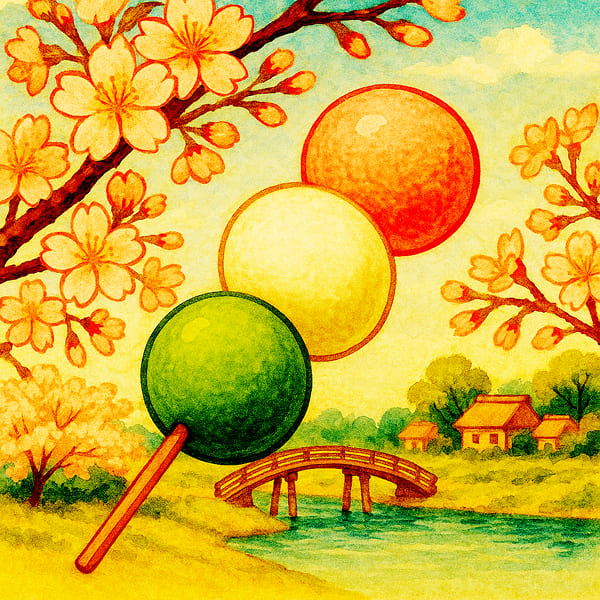Dango: Japan’s Beloved Traditional Sweet That Celebrates the Seasons

Contents
A warm, chewy dumpling with a story to tell.
From spring cherry blossoms to autumn moon-viewing nights, dango (団子) has long been more than just a simple indulgence in Japan. These soft, skewered rice dumplings offer a glimpse into Japan’s harmony with nature and the rhythm of seasonal life. Whether glazed with sweet soy sauce or topped with red bean paste, each variety of dango carries its own cultural charm—and every bite connects you to centuries of Japanese heritage.
What Is Dango? A Staple of Japanese Wagashi
Dango is a classic example of wagashi — traditional Japanese confectionery. Made from rice-based flours like jōshinko (non-glutinous rice) and sometimes shiratamako (glutinous rice), dango varies in texture and taste depending on the ingredients and region. Some are soft and delicate, while others are firmer and chewier.
What Is Kushi Dango?
One of the most common styles of dango is kushi dango (skewered dumplings). Typically served with three to five small dumplings on a bamboo skewer, kushi dango is both portable and easy to share. It’s often sold at festivals, tea houses, and street stalls, making it a familiar treat across Japan.
Depending on the toppings or sauces, kushi dango comes in a variety of flavors and styles. Below are some of the most beloved types.
Popular Varieties of Dango
- Mitarashi dango – Grilled dango covered in a sweet soy sauce glaze; a timeless favorite.
- An dango – Topped with sweet anko (red bean paste), offering a smooth, earthy flavor.
- Sanshoku dango – A festive variety often seen in spring, known for its pink, white, and green colors.
Dango and Japan’s Seasonal Traditions
One of dango’s most charming qualities is its deep connection to seasonal festivals and customs. Among these, two types stand out for their seasonal symbolism: sanshoku dango and tsukimi dango.
Sanshoku dango — also known as hanami dango — is a springtime favorite enjoyed during hanami (cherry blossom viewing). The colors of these three dumplings reflect the shifting seasons:
- Pink – Cherry blossoms of spring
- White – Lingering snow
- Green – Fresh buds of new life
Tsukimi dango, on the other hand, is prepared in autumn for Tsukimi, the moon-viewing festival. Traditionally plain white and often arranged in a pyramid, these dumplings are offered as a symbol of gratitude for the harvest. In some regions, particularly in Western Japan, they may be coated with sweet red bean paste.
Dango is more than just food—it’s a poetic reflection of Japan’s connection to nature and seasonal change.
Cultural Symbolism: Harmony in Every Bite
Dango beautifully reflects the Japanese spirit of wa (和), or harmony. Despite its simple ingredients, it is carefully prepared to express thoughtfulness and seasonal beauty.
Far from being a luxury, dango is a sweet embraced by all generations. Found at street stalls, traditional sweet shops, and matsuri (festivals), it’s more than just a snack — it’s part of everyday life. Sharing dango with family or friends brings moments of connection and joy.
Where to Try Dango in Japan?
If you’d like to taste authentic dango during your visit to Japan, here are some well-known shops in Tokyo and Kyoto.
Tokyo – Asakusa Area
-
Asakusa Kibidango Azuma Located right in the heart of Nakamise Street near Sensoji Temple, this charming shop specializes in kibi dango—a soft and chewy dumpling dusted with roasted soybean flour. Served fresh with a cup of sweet sake in winter or iced tea in summer, it’s a nostalgic treat that connects to Edo-period street culture.
-
Kikuya Nakamise A long-established wagashi shop offering classic mitarashi and anko dango. Founded over 100 years ago, it remains a favorite for both locals and visitors strolling through Nakamise. English menu available on their website.
Kyoto – Historic & Cultural Centers
-
Kamo Mitarashi Chaya
Said to be the birthplace of mitarashi dango, this shop near Shimogamo Shrine has a deeply traditional atmosphere. Their dumplings are slightly charred and covered in a light soy glaze—a perfect blend of sweet and savory. Popular among locals and pilgrims alike. -
Fujinami Dango
With multiple locations in Kyoto (including Sannenzaka and JR Kyoto Isetan), Fujinami serves beautiful Kyoto-style wagashi such as mitarashi dango, matcha dango, and warabi mochi. -
Terakoya Honpo
Located in the lively Nishiki Market, this shop offers a variety of skewered dango with seasonal toppings like sakura, sweet potato, or yuzu. A great stop while exploring Kyoto’s famous food market.
No matter where you travel in Japan, enjoying dango is a delicious and accessible way to experience the country’s seasonal beauty and timeless hospitality.
More Than a Sweet: Dango and the Heart of Japan
Whether you’ve tasted it yourself or are just learning about it from afar, dango offers a gentle window into the rhythms of Japanese life. Its soft texture, seasonal colors, and humble ingredients embody the spirit of wa—harmony, simplicity, and connection.
From cherry blossom picnics to moon-viewing nights, dango is more than just a traditional confection. It is a symbol of how Japan celebrates the passage of time, the beauty of nature, and the joy of sharing something small, yet meaningful.
In a fast-paced world, dango invites you to slow down. To savor. To appreciate.
Even if you’ve never held a skewer in your hands, the story it tells is universal:
A story of culture, of care, and of finding meaning in the everyday.